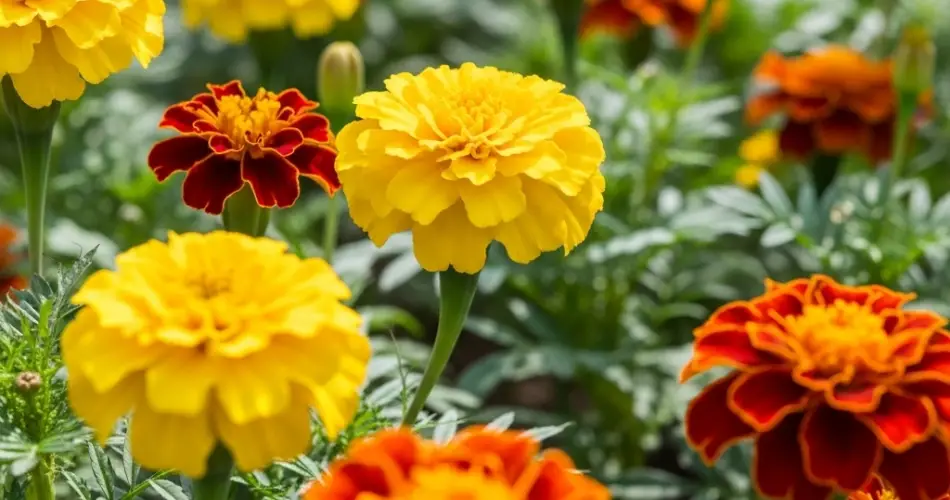Marigolds are more than just cheerful, vibrant flowers that add color to your garden—they’re also powerful allies in organic gardening. Their ability to repel pests, attract pollinators, and support nearby plants makes them ideal candidates for companion planting. Whether you’re growing vegetables, herbs, or ornamental flowers, marigolds can improve plant health and productivity in natural, sustainable ways. In this guide, you’ll learn how to use marigolds effectively as companion plants and which crops benefit the most from their presence.
Why Use Marigolds in Companion Planting?
Companion planting involves strategically placing plants together to maximize their growth, minimize pests, and improve soil health. Marigolds, particularly French and African varieties, are widely used in this practice due to their unique properties:
-
Pest Repellent: Marigolds emit a strong scent and release natural compounds that deter common garden pests like aphids, nematodes, whiteflies, and cabbage worms.
-
Pollinator Magnet: Their bright blooms attract bees, butterflies, and other pollinators, which help nearby fruiting plants develop more produce.
-
Soil Health Support: Certain marigolds (notably Tagetes species) release root exudates that suppress harmful nematodes in the soil.
-
Trap Crop: Marigolds can draw pests away from more delicate vegetables, acting as a sacrificial plant to protect the rest of your garden.
Best Types of Marigolds for Companion Planting
Not all marigolds are equally effective for pest control. For the best results, choose the right species for your specific garden needs:
-
French Marigolds (Tagetes patula): Compact and highly effective at repelling nematodes and aphids. Great for vegetable gardens.
-
African Marigolds (Tagetes erecta): Taller with larger blooms. Good for attracting pollinators and repelling pests, though less potent against nematodes.
-
Signet Marigolds (Tagetes tenuifolia): Smaller flowers with edible petals. Useful for borders and visual appeal, but slightly less pest-repelling.
Top Plants to Pair with Marigolds
1. Tomatoes
Tomatoes benefit greatly from marigolds, which help repel aphids, whiteflies, and hornworms. Plant marigolds around the base of tomato plants or in between rows to form a protective barrier.
2. Cucumbers
Marigolds can deter cucumber beetles, which chew on leaves and transmit bacterial wilt. Interplanting marigolds with cucumbers reduces the chance of infestations.
3. Peppers
Both hot and sweet peppers can suffer from aphid and thrip infestations. Marigolds help by masking the scent of pepper plants and keeping these pests away.
4. Beans
While beans are generally low-maintenance, marigolds can enhance pest resistance, especially against beetles and aphids. Plant marigolds at the end of bean rows or around bean mounds.
5. Cabbage Family (Brassicas)
Cabbage, broccoli, cauliflower, and kale attract cabbage moths and root maggots. Marigolds help mask the scent and act as a natural deterrent.
6. Squash and Zucchini
Squash bugs and aphids are common problems for these crops. Companion planting marigolds in nearby beds can help keep these pests in check.
How to Plant Marigolds for Maximum Benefit
Choose the Right Location
Marigolds love full sun and well-drained soil. For best results, plant them near the crops you want to protect but give each plant enough space to avoid overcrowding.
Spacing and Arrangement
-
Border Planting: Create a perimeter of marigolds around vegetable beds to form a pest-repelling barrier.
-
Interplanting: Place marigolds in between rows or within garden beds, alternating with your main crops.
-
Container Gardening: Marigolds thrive in containers and can be placed next to potted herbs or vegetables on patios or balconies.
Timing
Start marigold seeds indoors 4–6 weeks before the last frost or sow directly into the ground once the soil has warmed. Because they grow quickly, you can even plant them mid-season if pest problems arise.
Other Benefits of Growing Marigolds
-
Deer and Rabbit Deterrent: Marigolds have a pungent scent that discourages deer and rabbits from entering your garden.
-
Easy to Grow: These annuals are low-maintenance, drought-tolerant, and bloom all season with minimal care.
-
Visual Appeal: With bright orange, yellow, and red flowers, marigolds enhance the overall beauty of your garden.
What Not to Plant with Marigolds
While marigolds pair well with most vegetables, avoid planting them too close to:
-
Beans (in large quantities): Some gardeners report stunted bean growth when marigolds are planted densely nearby.
-
Cabbage in shaded areas: Marigolds need full sun, and shaded areas may cause poor growth and fewer pest-repelling effects.
Final Thoughts
Incorporating marigolds into your companion planting strategy is a simple and effective way to improve the health and productivity of your garden. With their pest-repelling abilities, bright colors, and low-maintenance care, marigolds offer both functional and aesthetic value. Whether you’re growing tomatoes, squash, or leafy greens, these versatile flowers can help create a more balanced, thriving ecosystem in your garden—all without the need for chemical pesticides.



